South or Bust
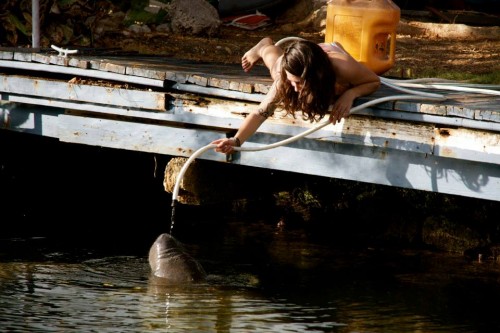
To paraphrase graduate student and Chattermarks contributor Samantha Hale: This weather? It ain’t normal. Or at least, these no-Gore-tex-required skies and 50 degree Fahrenheit temperatures may be a little out of the ordinary, but they still did not stop more than a few of the staff and graduate students at the North Cascades Institute from venturing to more traditionally sun-struck lands this past winter break. Whether it was Hale sailing off the Floridian coast, Amy Brown putting her flamingo-watching skills to use in Colombia, or myself feeling re-connected in California, we all imitated the birds and flew south. —Katherine Renz
Golden Brown: Of Drought and Draught
By Katherine Renz
It was already past noon when my best bud, Kelsey, and I drove north across the Golden Gate Bridge toward our hiking destination, the undulating hills of the Marin Headlands. I’d been back in my native California almost a week already, and was getting used to the inescapable sign of major drought all through the Coast Ranges: not a single blade of wintertime green grass, nor even the characteristic golden version. Just dirt. Just brown. After six months of living amidst northwestern Washington’s emerald understory and constant wet decay, this was both a refreshing change and a depressing, scary homecoming. But the Headlands are family, and I would happily hike within it in its emergency state of dehydration, if that was what was offered.
Kels and I climbed and descended the hills between our Mill Valley starting point and Muir Beach toward the end. The “Coastal Trail”, a small snippet of the California Coastal Trail, paralleled the ocean for about three miles. Reuniting with cliffside scrub species like lizard tail and Artemisia californica was nearly as good as seeing old friends at a party the night before (and in some cases, better). Soon enough, we reached the classic destination for this trip: the Pelican Inn, a pub modeled after 16th century Tudor-style buildings, complete with a dart board, a lawn for the picnicking overflow, and a dark dining room with long wooden tables reminiscent of a feast scene from Game of Thrones.
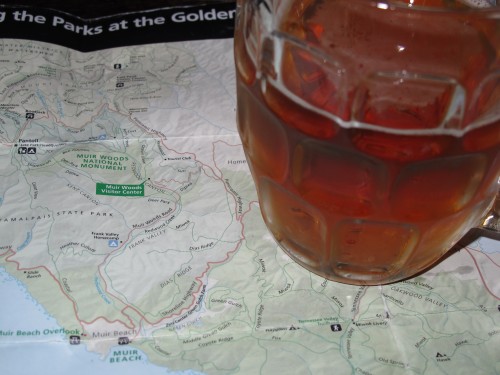 Perfection. Photo by Katherine Renz.
Perfection. Photo by Katherine Renz.
A freshly poured pint with a plate of meat and cheese has to be one of the best mid-hike treats found in the frontcountry. Substantially refueled, we were smarter on the return trip towards San Francisco, choosing the paths that zigged and zagged along the ridges rather than the knee-crushing peak-valley-peak-valley of the Coastal Trail. We were privileged to pass through Green Gulch Farm, a Zen practice center that combines meditation with spending time in the natural world and doing physical work. Between the dry coastal foothills and the huge organic gardens of the Buddhist retreat, I knew I was home, and had to keep myself from mauling every tick-ridden coyote brush (Bacchus pilularis) in a show of loving kinship.
It was December 22nd, the day after winter solstice. I’d stayed in my tank top throughout the entire hike, stubborn and thrilled to expose my pale arms to the California chill even as the sun plunged softly, burning, into the Pacific.
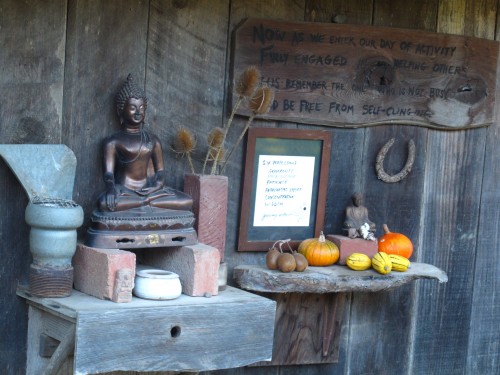 Garden shed altar at the Green Gulch Zen Center. Photo by Katherine Renz.
Garden shed altar at the Green Gulch Zen Center. Photo by Katherine Renz.
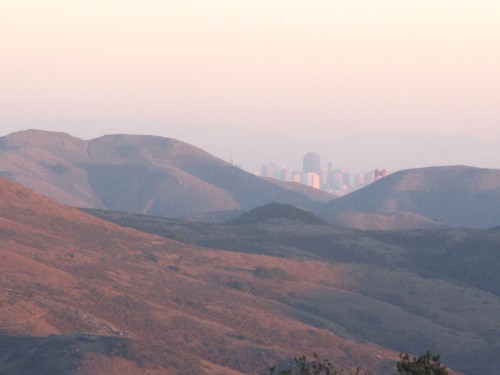 The tops of the ubiquitous coyote brush poke up in the foreground and the pointed peaks of two of San Francisco’s most characteristics landmarks, the Transamerica Pyramid and the Golden Gate Bridge, are barely visible and snug between the rolling Headlands. This land is part of the Golden Gate National Recreation Area, one of the largest urban parks in the world, with a size two-and-a-half times that of the consolidated city and county of San Francisco. Photo by Katherine Renz.
The tops of the ubiquitous coyote brush poke up in the foreground and the pointed peaks of two of San Francisco’s most characteristics landmarks, the Transamerica Pyramid and the Golden Gate Bridge, are barely visible and snug between the rolling Headlands. This land is part of the Golden Gate National Recreation Area, one of the largest urban parks in the world, with a size two-and-a-half times that of the consolidated city and county of San Francisco. Photo by Katherine Renz.
Salty and Sweaty in the Sunshine State
By Samantha Hale
I’ve lived in Washington only half a year and already know that the recent weather isn’t normal. In 2013, both summer and fall were full of blue skies, not the rain that I was promised by so many. But with the arrival of winter, the rains came, and the blue sky and sun disappeared above the high peaks I’d spent so many months memorizing. Though I am not one to crave warmer temperatures, the promise of winter break had me yearning for sun. And so, I went searching. Destination: Key Largo, Florida.
The day I flew out of Seattle it was 15 degrees Fahrenheit and massive ice storms raged throughout the country. I almost didn’t make it out of Washington. I spent hours at the check-in desk while the most amazingly patient American Airlines employee booked me on cancelled flight after cancelled flight, until she found one that would get me to Florida. It was a rough start in my search of sunshine and ocean adventures, but it was worth it. The next day I arrived in Florida, greeted by temperatures in the 60s, humidity, brilliant sun and a cloudless sky.
I was going to spend a week sailing with a friend who had formerly lived for many years just north of Bellingham. He, too, had just arrived in Key Largo and we both waited for my baggage, sweating through our first outfit of the day. We spent the rest of the afternoon preparing his little sailboat for the ocean. The evening was spent among good friends, grilling chunks of freshly caught fish and sitting under the stars with bug lamps shining strong.
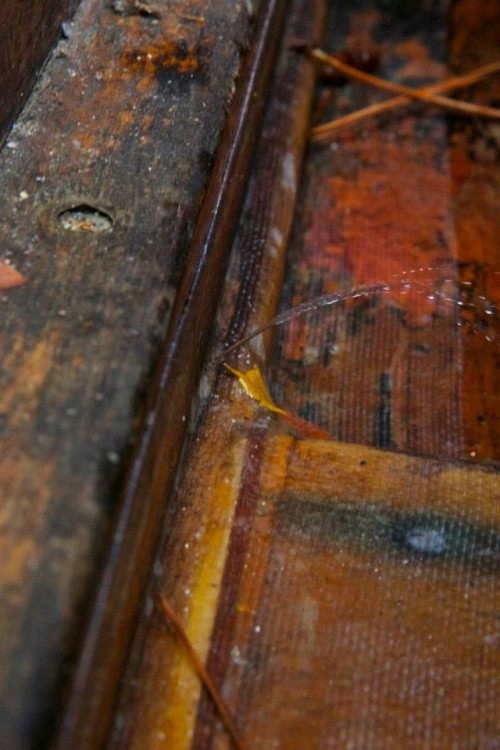 The wooden boat had a few leaks, but once it sat in saltwater for a few days it swelled up and all the leaks disappeared. Photo by Liam McDonnell.
The wooden boat had a few leaks, but once it sat in saltwater for a few days it swelled up and all the leaks disappeared. Photo by Liam McDonnell.
The next day we launched his tiny wooden boat into the Atlantic Ocean. It had just arrived, like its owner, from the shores of Lake Tahoe and was in for a different, more tropical life.
The rest of the week was spent in warm bliss. In this flat land of the lower latitudes, the sun stayed in the sky longer than I was used to at the Environmental Learning Center, giving the week a dreamlike quality. The days were long, the nights longer. Friendship and adventure were in abundance, and my land legs remained packed in my luggage for a later date. We snorkeled on offshore reefs, had close encounters with manatees and gorged ourselves on freshly caught seafood. I was introduced to wooden boat sailing (and the idea that they break often, but you love them more for that reason) and “hook and cook”, in which you catch your own seafood and bring it to a local restaurant for them to prepare.
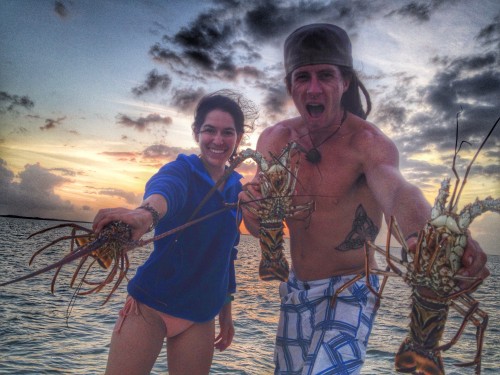 Local ocean grub: Graduate student Hale with Captain McDonnell getting their crustacean catch for “hook and cook”. Photo by Alden Rowe.
Local ocean grub: Graduate student Hale with Captain McDonnell getting their crustacean catch for “hook and cook”. Photo by Alden Rowe.
All too quickly, the week came to an end. It was glorious being in the warm sun, but the bugs were ferocious and the land too flat. I will miss the sound of the ocean lulling me to sleep and the sweet, salty sea breeze, but am looking forward to continuing my explorations of the amazing wilderness of the North Cascades, my home.
Taking Flight
By Amy Brown
 Who knew that real live flamingos are actually brighter and more colorful than those plastic lawn ornaments? Photo by Eric Mickelson.
Who knew that real live flamingos are actually brighter and more colorful than those plastic lawn ornaments? Photo by Eric Mickelson.
This December, I had the unique opportunity to travel to Colombia. It is big and diverse country, with multiple mountain ranges that soar over 18,000 feet, two oceans, friendly people and relatively few tourists. It offers awesome birding opportunities, beautiful rivers, tons of beaches, enough tourist infrastructure without tons of tourists and the opportunity to buff up my beginner Spanish. My husband and I booked plane tickets for a three-week trip.
Before we left, a friend and colleague recommended we visit Santuario de Flora y Fauna Los Flamencos (“Flamingo Nature Reserve”), a 700-hectare reserve along the Caribbean Coast. He was adamant: “Do not miss it,” he said. Being avid birders and having never seen flamingos before except in a zoo, we taxied from our beachside lodging in Palomino east to Camarones, the closest small town to the sanctuary. The contrast from Palomino, where we were staying at a finca on the beach, was incredible. Just an hour’s taxi ride had transported us from lush, tropical jungle to desert-like, dry tropical forest. Four coastal marshes and salty lagoons separated from the sea by a shallow sand bar provide perfect flamingo habitat, attracting thousands of American Flamingos (Phoenicopterus ruber) who congregate in large flocks to feed and nest during the wet season from September through December. Our friend was right. The Santuario proved to be one of the highlights of our trip.
Visiting the reserve was also the chance to get to know the colorful Wayuu culture, an Amerindian ethnic group who lives both in the far north of Colombia on the Guajira Peninsula and in Venezuela. Our Wayuu guide took us out in a canoe hand-carved from a Ceiba tree with an ingenious sailing set-up: a well-worn green plastic tarp and a 12-foot long mast which he inserted into a hole in one of the canoe seats.
 Resourceful, colorful sailing by a Wayuu guide at the Flamingo Nature Reserve. Photo by Eric Mickelson.
Resourceful, colorful sailing by a Wayuu guide at the Flamingo Nature Reserve. Photo by Eric Mickelson.
After sailing for about 15 minutes across the lagoon, occasionally getting stuck on the mussel shoals that lined the shallow bottom, we spotted our first birds, including Roseate Spoonbills, White Ibises, Snowy Egrets, Little Blue Herons, Great Blue Herons, Wood Storks, Great Egrets and more. These alone would have been enough to make us feel satisfied with the excursion.
But then, we spotted a wide smudge of pink about a half-kilometer away. As we came closer, we could see a flock of 500-plus American Flamingos standing in the lagoon. To feed, flamingos use their curious-shaped bills (technically called “ventroflexed”) to strain algae, brine flies, shrimp and small fish out of the water by inverting their heads underwater and holding their bills nearly horizontal. The real show, however, began when they took to the air. Anyone who’s seen snow geese wintering in the Skagit Valley knows how magical it is to see them take wing in huge flocks numbering in the thousands over your head, the drum of wing beats reverberating through the air. So you can imagine our awe when the entire flock of flamingos suddenly took flight, and we had the chance to stare in wonder at these fabulously beautiful and awkward-looking birds winging over us. All impossibly long legs and necks with short, down-curved bills and bright, coral wings — it seems almost unbelievable that such a fascinating creature evolved.
Given that we’d arrived with very few expectations or information about our visit to the reserve, we were delighted. If you ever have the chance to visit this gem of a country, as my friend said, do not miss seeing the flamingos!
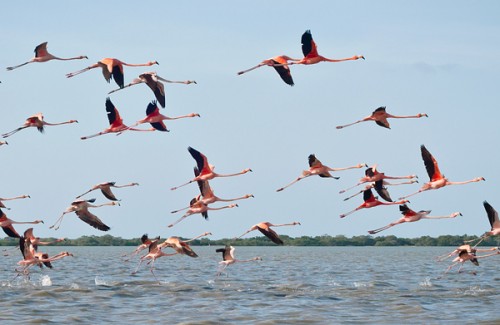 Pretty in pink. Photo by Eric Mickelson.
Pretty in pink. Photo by Eric Mickelson.
Leading photo: Samantha Hale and her manatee friend on the coast of Key Largo, Florida.
Samantha Hale and Katherine Renz are both graduate students in North Cascades Institute and Western Washington University’s M.Ed. program. Amy Brown is an award-winning educator who has led the Institute’s Youth Leadership Adventures program since its inception in 2006.

